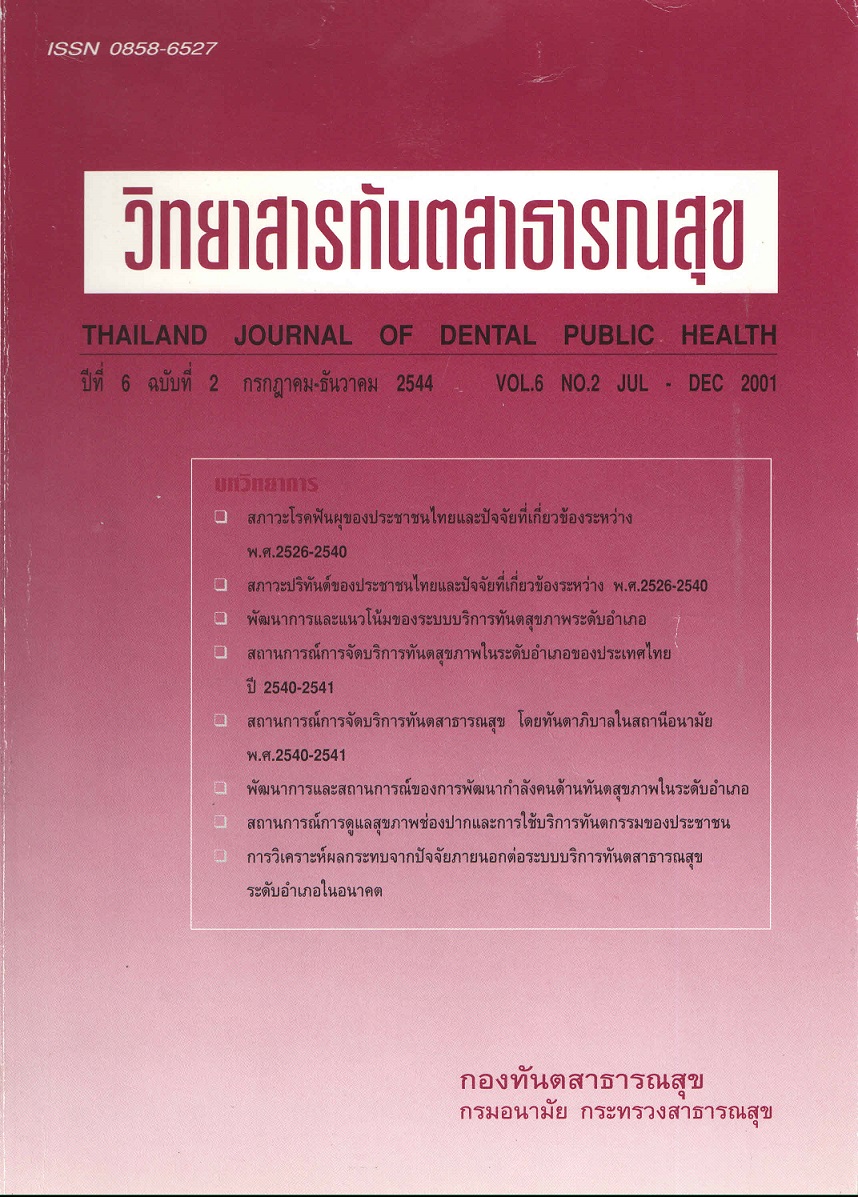Articles The study of the impacts of external factors on the future dental health service system in district level.
Main Article Content
Abstract
This study aimed at studying how the changes of external factors influence the future dental health service system. These factors were : the economic crisis situations, public reforms and public personnel-freezing policies, and decentralization. The study was carried out by reviewing the relevant documents, and interviewing the high level administrators and senior technical officials of ministry of public health and the external senior experts.
The study revealed that the economic recession during 1997-1999 had led to the decrease of the annual public health budgets in these consecutive years, resulting to a reduction of dental units supply for district level. According to the public reforms, there would be a transfer of public health mission to the local authorities. With the need of more flexible and efficient management of the future limited resources, the public health facilities might be needed to be the autonomous hospitals. And due to the personnel-freezing policies of the government, the public health facilities might have to recruit the desired personnel as employees paid from the hospital revenue. Concerning the decentralization practice, only few local authorities were providing public health services to the population. From the document reviews, many local authorities at Tambon levels were not ready to do so. But those which could do were providing a few and limited public health services, mostly related to sanitation, environmental health and primary health care activities.
The study concluded and recommended that: (1) the health care system in the future has to be focused on the efficient management of resources and more ownership of local community, (2) the transformation of public hospitals under the central government to be those under the local authorities or the autonomous hospitals really needs to be well prepared in terms of human resources for health development according to the suitable health care model for local authorities to serve the population, and (3) besides those who are permanent officials, some health personnel will be employed temporarily by the public hospitals or local authorities by using their own budgets.
Downloads
Article Details
References
2. สํานักงานคณะกรรมการพัฒนาเศรษฐกิจและสังคมแห่งชาติ แนวโน้มเศรษฐกิจไทยในระยะปานกลาง (2542-2544) เอกสารเสนอต่อคณะรัฐมนตรีว่าด้วยนโยบายเศรษฐกิจ, หน้า 2-5 , 2 มีนาคม 2541
3. สถาบันวิจัยระบบสาธารณสุข วิกฤตการคลังโรงพยาบาลรัฐ ปัญหาและทางออก จดหมายข่าวสถาบันวิจัยระบบสาธารณสุขฉบับพิเศษ ,1/2542
4. วิโรจน์ ตั้งเจริญเสถียร, จงกล เลิศเกียรดํารง, ยงยุทธ ขจรธรรม ผลกระทบของค่าเงินบาท ลอยตัวต่อต้นทุนในภาคสาธารณสุข สิงหาคม 2540
5. มติคณะรัฐมนตรี เมื่อวันที่ 19 สิงหาคม 2540
6. มติการประชุม ก.พ. เมื่อวันที่ 8 ธันวาคม 2540
7. มติคณะรัฐมนตรี เมื่อวันที่ 23 พฤษภาคม 2538
8. กองราชการส่วนตําบล กรมการปกครอง คู่มือพนักงานส่วนตําบล ,2539
9. กองราชการส่วนตําบล กรมการปกครอง ข้อมูลสภาตําบลและองค์การบริหารส่วนตําบลประจําปี 2540 โรงพิมพ์ส่วนท้องถิ่น กรมการปกครอง 2540
10. ประยงค์ เต็มชวาลา, การกระจายอํานาจ : ยุทธศาสตร์การปฏิรูปงานสาธารณสุขไทย ศูนย์ฝึกอบรมและพัฒนาการสาธารณสุขมูลฐานภาคกลาง, 2540
11. ส่วนแผนงานและทรัพยากรสาธารณสุข สํานักนโยบายและแผนสาธารณสุข,สถานภาพและความ พร้อมขององค์การบริหารส่วนตําบล (อบต.) และสถานีอนามัย (สอ.) ในการดําเนินงานพัฒนาสาธารณสุขเพื่อรองรับการกระจายอํานาจสู่ท้องถิ่น, 2539
12. เกรียงศักดิ์ อัญประเสริฐกุล, องค์การบริหารส่วนตําบลกับการบริหารจัดการงานสาธารณสุขมูลฐาน : ความมั่นใจและคาดหวังของชุมชน, กรกฎาคม 2539
13. ศิริวัฒน์ ทิพยธราดล สมปอง จันทพันธ์ บัน ยีรัมย์ และคณะ, องค์การบริหารส่วนตําบล (อบต.) กับการพัฒนาด้านสาธารณสุขและสิ่งแวดล้อม จังหวัดหนองคาย,กรกฎาคม 2540


